Harry S. Truman Worksheets
Do you want to save dozens of hours in time? Get your evenings and weekends back? Be able to teach about Harry S. Truman to your students?
Our worksheet bundle includes a fact file and printable worksheets and student activities. Perfect for both the classroom and homeschooling!
Resource Examples
Click any of the example images below to view a larger version.
Fact File
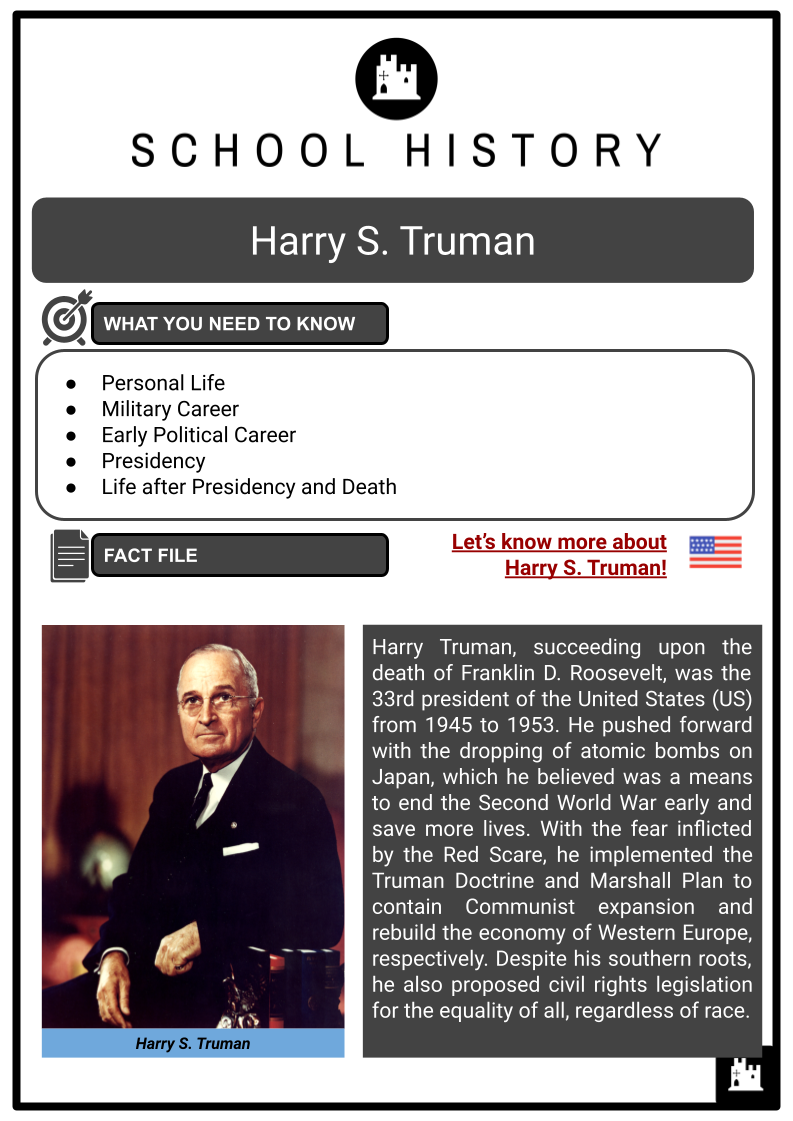
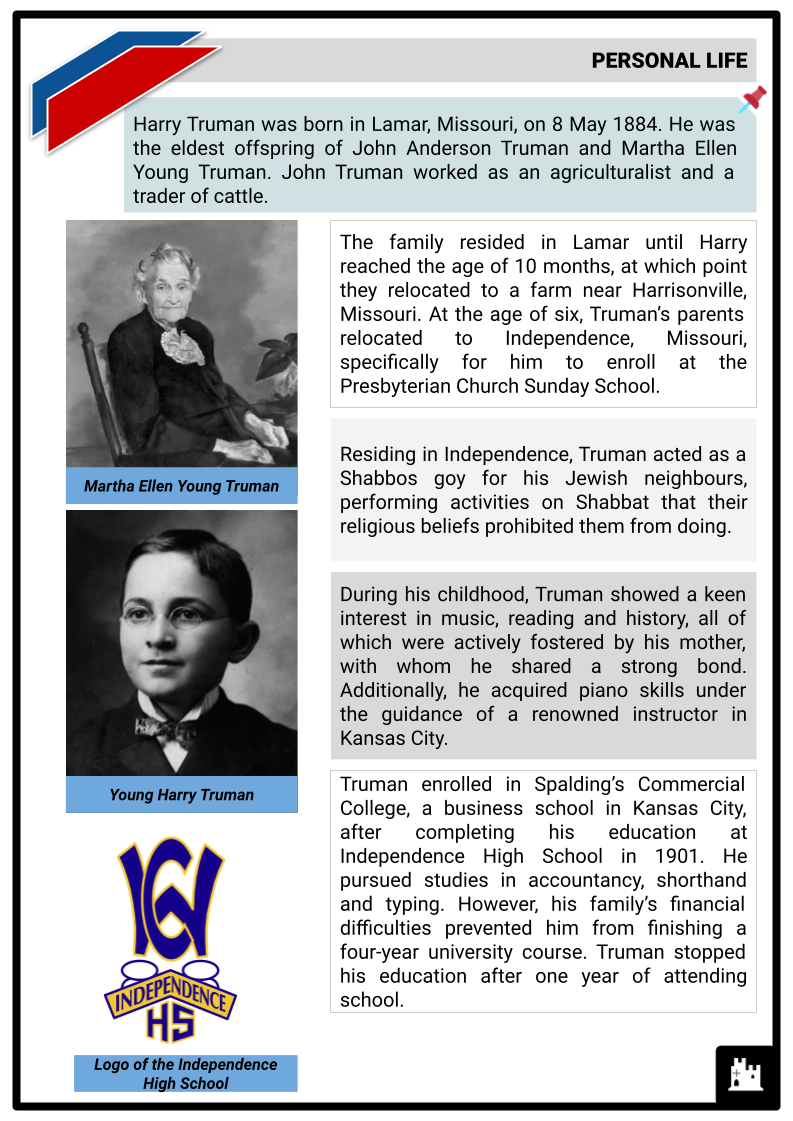
Student Activities
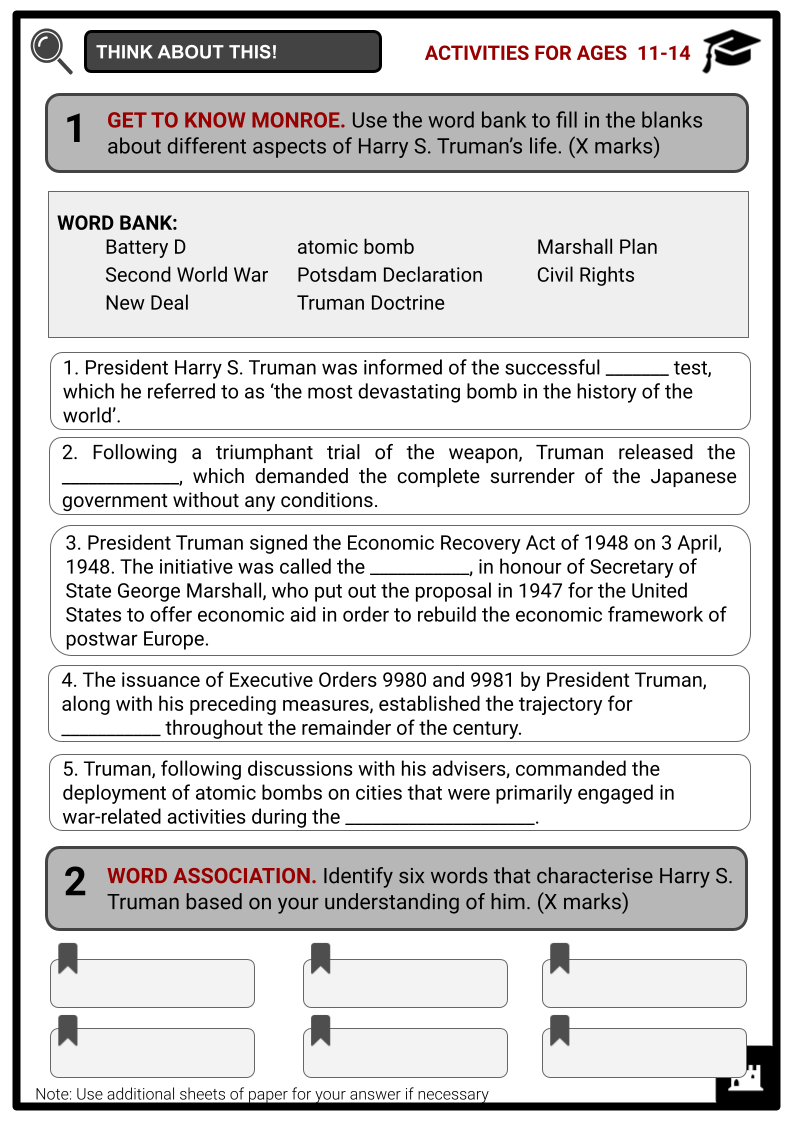
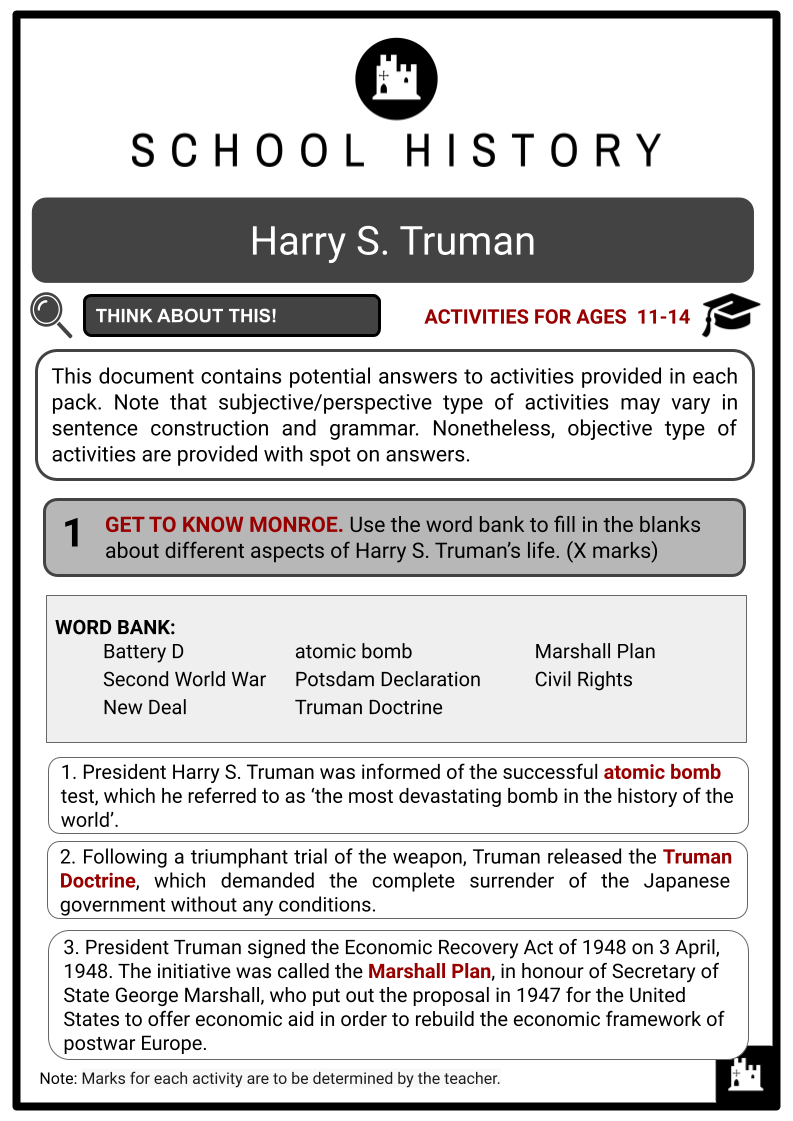
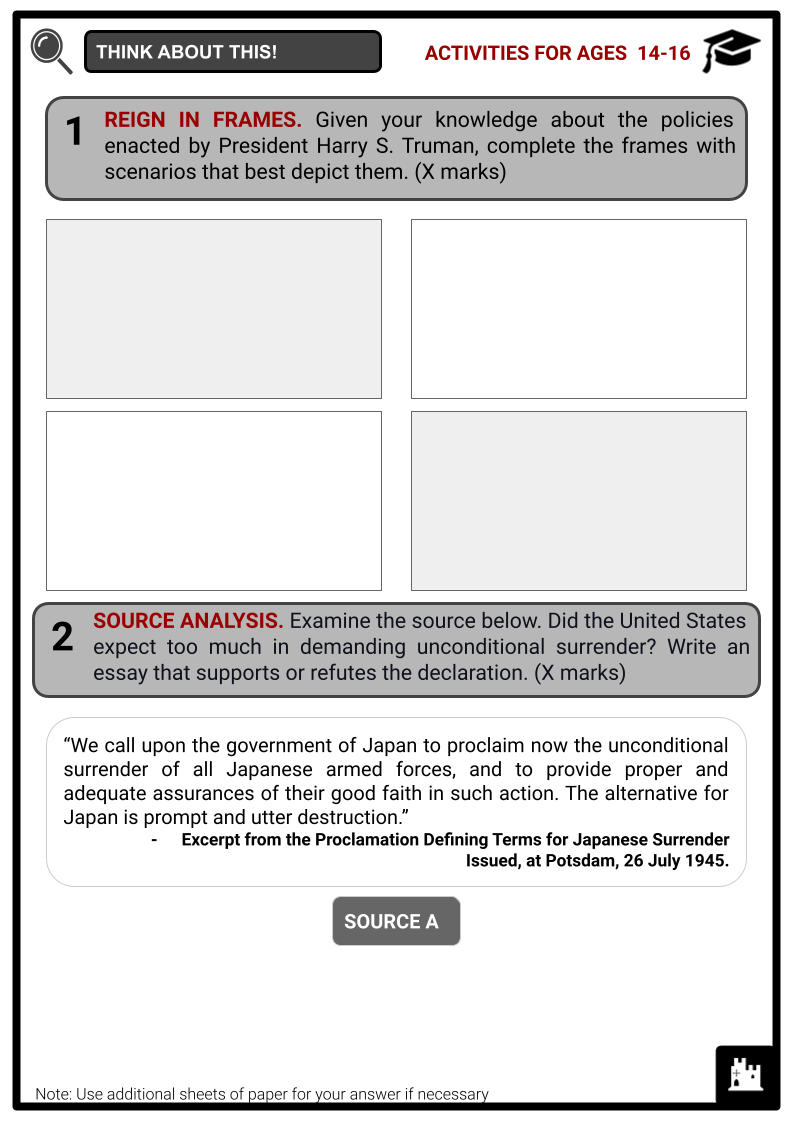
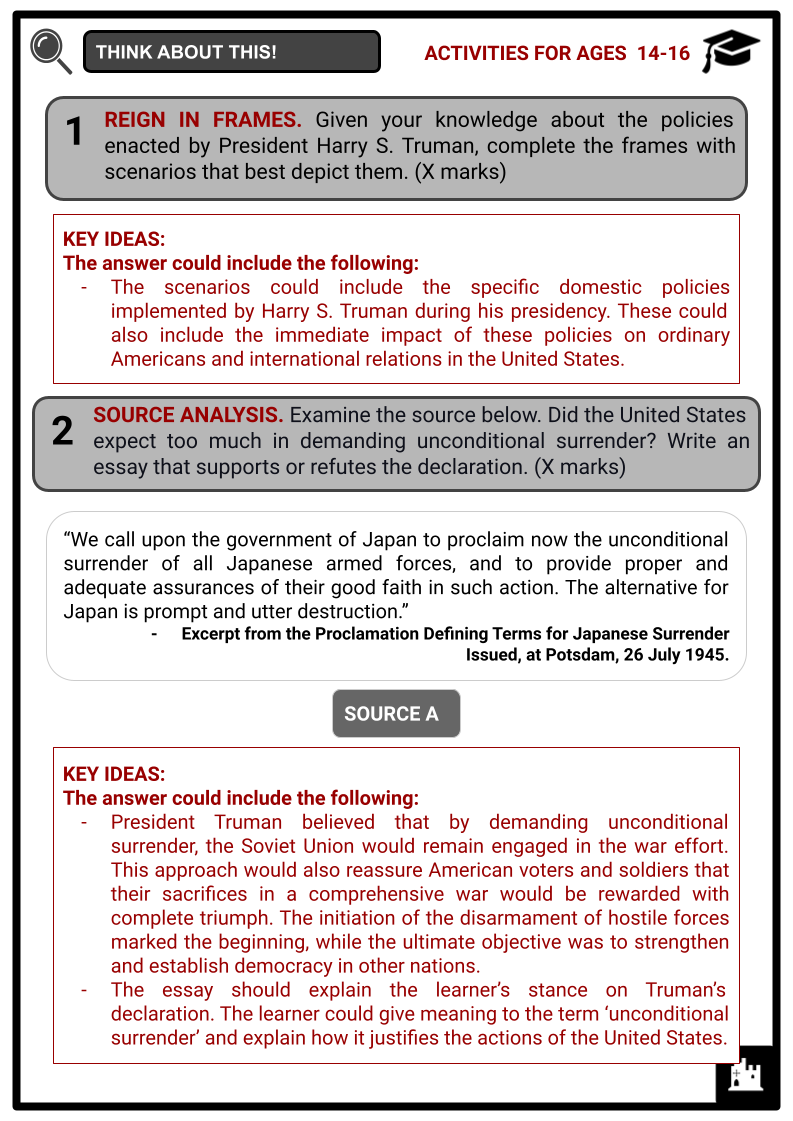
Summary
- Personal Life
- Military Career
- Early Political Career
- Presidency
- Life after Presidency and Death
Key Facts And Information
Let’s know more about Harry S. Truman!
Harry Truman, succeeding upon the death of Franklin D. Roosevelt, was the 33rd president of the United States (US) from 1945 to 1953. He pushed forward with the dropping of atomic bombs on Japan, which he believed was a means to end the Second World War early and save more lives. With the fear inflicted by the Red Scare, he implemented the Truman Doctrine and Marshall Plan to contain Communist expansion and rebuild the economy of Western Europe, respectively. Despite his southern roots, he also proposed civil rights legislation for the equality of all, regardless of race.
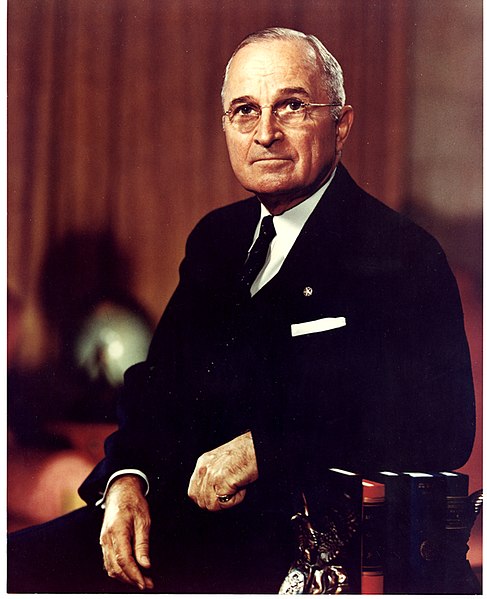
PERSONAL LIFE
- Harry Truman was born in Lamar, Missouri, on 8 May 1884. He was the eldest offspring of John Anderson Truman and Martha Ellen Young Truman. John Truman worked as an agriculturalist and a trader of cattle.
- The family resided in Lamar until Harry reached the age of 10 months, at which point they relocated to a farm near Harrisonville, Missouri. At the age of six, Truman’s parents relocated to Independence, Missouri, specifically for him to enroll at the Presbyterian Church Sunday School.
- Residing in Independence, Truman acted as a Shabbos goy for his Jewish neighbours, performing activities on Shabbat that their religious beliefs prohibited them from doing.
- During his childhood, Truman showed a keen interest in music, reading and history, all of which were actively fostered by his mother, with whom he shared a strong bond. Additionally, he acquired piano skills under the guidance of a renowned instructor in Kansas City.
- Truman enrolled in Spalding’s Commercial College, a business school in Kansas City, after completing his education at Independence High School in 1901. He pursued studies in accountancy, shorthand and typing. However, his family’s financial difficulties prevented him from finishing a four-year university course. Truman stopped his education after one year of attending school.
- Truman returned to the Grandview farm in 1906 and resided there until he joined the army in 1917. During this time, he pursued a romantic relationship with Bess Wallace.
- In 1911, Bess declined Truman’s offer of marriage. However, their romantic relationship persisted. They got married in 1919, and after five years, they had their only child, Mary Margaret Truman.
- In 1914, following the death of his father, Truman unsuccessfully attempted to support himself by owning and operating a small mining firm and oil business while also maintaining his involvement with the farm.
- Truman temporarily attended business college and pursued evening classes for a Bachelor of Laws degree at the Kansas City Law School from 1923 to 1925. However, he stopped his studies after failing to win re-election as county judge.
MILITARY CAREER
- Truman contemplated enrolling at the United States Military Academy at West Point, New York, due to insufficient funds for college. However, his application was rejected due to his visual impairment. In 1905, he joined the Missouri National Guard and served until 1911 in Battery B, 2nd Missouri Field Artillery Regiment, based in Kansas City. During his service, he achieved the rank of corporal.
- Upon the United States’ entry into the First World War on 6 April 1917, Truman resumed his service in Battery B, skillfully enlisting additional soldiers for the growing unit, resulting in his election as its inaugural lieutenant.
- Prior to being deployed to France, Truman trained at Camp Doniphan, located outside Lawton, Oklahoma, as his regiment, the 129th Field Artillery, was federalised.
- During his training, Robert M. Danford, who later became the Army’s Chief of Field Artillery, was the regimental commander.
- By mid-1918, almost one million American Expeditionary Forces (AEF) soldiers were present in France. Truman received a promotion to the rank of captain on 23 April 1918.
- In July, he assumed command of Battery D, 129th Field Artillery, 35th Division, which had recently arrived. Battery D was notorious for its disciplinary issues, and Truman faced immediate unpopularity due to his endeavours to reinstate order.
- Battery D was notorious for its disciplinary issues, and Truman faced immediate unpopularity due to his endeavours to reinstate order. Truman managed to overcome the efforts of the men to bully him into giving up by holding his corporals and sergeants responsible for maintaining discipline.
- Truman’s leadership talents were evident during the war, making it a transforming experience for him. In 1917, he joined the service and held clerical positions that did not involve leading or motivating others.
- However, during the war, he gained valuable leadership skills and achieved notable success, which greatly benefited his political career in Missouri after the war.
- Truman’s acquisition of leadership and interpersonal abilities, which contributed to his success as a politician, enabled him to establish positive relationships with his Catholic soldiers, soldiers from other Christian denominations, and the Jewish members of his unit.
- Truman received an honourable discharge from the Army with the rank of captain on 6 May 1919. In 1920, he was designated a major in the Officers Reserve Corps.
- In 1925, he achieved the rank of lieutenant colonel, and in 1932, he was promoted to colonel. During the 1920s and 1930s, he was commanding officer for the 1st Battalion of the 379th Field Artillery within the 102nd Infantry Division.
- Following his advancement to the rank of colonel, Truman was promoted to commanding officer of the regiment he had served in.
- Following his election to the United States Senate, Truman was reassigned to the General Assignments Group, which served as a repository for officers with less active roles. However, Truman was only consulted after this transfer.
- He continued to serve as a reservist until the early 1940s. Truman offered to volunteer for active military duty in the Second World War, but his offer was declined.
- This was partly due to his age and also because United States President Franklin D. Roosevelt preferred senators and members of Congress who were part of the military reserves to continue supporting the war effort by staying in Congress or leaving their active duty service and returning to their seats in Congress.
EARLY POLITICAL CAREER
- Returning home from the war, Truman established a shop specialising in men’s accessories such as shirts, ties, trousers and socks. However, the shop did not offer suits, jackets or shoes. Truman started this venture in collaboration with a former army comrade.
- The shop experienced a failure within a short span of a few years. In 1922, Thomas J. Pendergast, the Democratic political leader of Kansas City, requested Truman to seek a position as a judge on the county court of Jackson County’s eastern district.
- After that, he assumed the presiding judge role in 1926, which he maintained until 1934.
- As the presiding judge, Truman oversaw the county’s finances during the initial stages of the Great Depression, which lasted from 1929 until the Second World War in 1939. The Great Depression was the most severe economic catastrophe in recent history.
- Although Truman was connected to Pendergast, he built a reputation for his integrity, honesty and efficiency.
- Truman was elected to the United States Senate in 1934, primarily due to the assistance of Pendergast. Senator Truman endorsed the New Deal, although his impact as a legislator was relatively minor.
- The New Deal refers to a collection of initiatives, including public infrastructure projects, financial restructuring and regulatory measures, that were implemented by Roosevelt in the United States from 1933 to 1938.
- He gained national prominence during the Second World War as the chairman of the Truman Committee, which investigated government defence expenditures.
- Roosevelt selected Truman as his vice-presidential candidate for the 1944 presidential campaign mainly because Southern Democrats and party officials approved Truman.
- The Roosevelt–Truman ticket decisively triumphed against the Republican opposition despite Truman’s short tenure of 82 days as vice president.
- Following the passing of Roosevelt on 12 April 1945, Truman assumed the role of the 33rd President of the United States.
PRESIDENCY
- As early as 1939, American physicists learnt of intelligence reports about the German development of nuclear fission. By June 1941, the United States created the Office of Scientific Research and Development.
Manhattan Project
- This new agency conducted joint research with the War Department for the development of a nuclear weapon under the Manhattan Project. On 16 July 1945, after four years of intensive research, an atomic device was tested in a desert near Alamogordo, New Mexico.
- At that time, and despite several firebombing operations, Japan refused to surrender. President Truman then believed that the new atomic bomb, a monstrous weapon, would more likely defeat Japan than any conventional invasion.
- On 6 August 1945, an atomic bomb was dropped on the city of Hiroshima, Japan. Three days later, on 9 August, another one was dropped on Nagasaki. Sixty per cent of Hiroshima’s infrastructure was destroyed.
- Around 140,000 people were killed in Hiroshima and 74,000 people in Nagasaki. Over the next five years, people died en masse from the effects of radiation.
Potsdam Conference
- While the destruction caused by the atomic bombs was heard in Tokyo, the Union of Soviet Socialist Republics (USSR) declared war on Japan on 8 August. Two days later, the Japanese government agreed to surrender under the terms stipulated in the Potsdam Declaration.
- Between 17 July and 2 August 1945, the heads of government for the United Kingdom, the United States and the Soviet Union convened in Potsdam, Germany. The Potsdam Conference began under a cloud of mistrust. Truman demanded a free election in Eastern Europe, but Stalin opposed it as it was anti-Soviet.
- Moreover, Truman hid the fact that the atomic bomb had been successfully tested. Even though the United States and the Soviet Union were allies during the Second World War, tension and mistrust were still present due to ideological differences.
- The United States promoted democracy and capitalism, while the Soviet Union sought socialism as a political and economic system. Some historians suggest that the United States used the atomic bomb as a warning to the Soviet Union as a show of strength of the American government.
Truman Doctrine
- In March 1947, Truman made two significant moves that had a massive effect on US society. He signed Executive Order 9835, also known as the Loyalty Order, which allowed the federal government to investigate federal employees’ beliefs and affiliations.
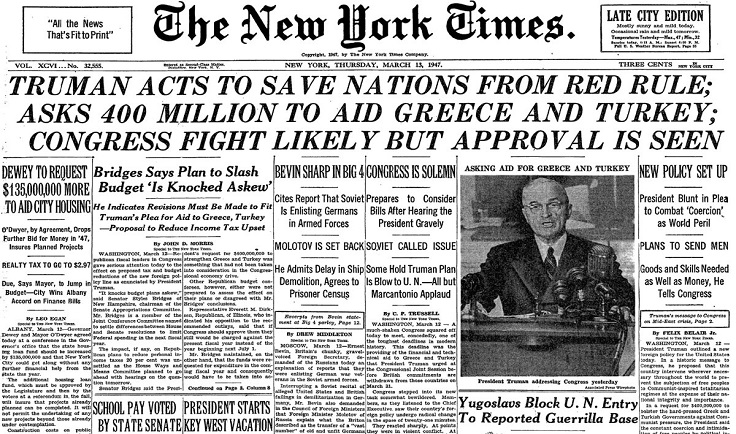
- Moreover, he also created the Truman Doctrine, a foreign policy to protect the United States from Soviet communist influence and geopolitical expansion. Measures of loyalty under Executive Order 9835 were:
- Espionage, sabotage, treason, sedition
-
- Membership in or association with any communist or subversive organisation
-
- Disclosure of confidential information
- As Britain faced economic problems after the war, it played a minimal role in the reconstruction process in the Mediterranean, specifically Greece and Turkey.
- In March 1946, in a broadcast speech from Westminster College in Fulton, Missouri, Winston Churchill stated that an ‘iron curtain’ had descended across the European continent. Soviet Union leader Joseph Stalin interpreted this as a war cry, but Truman countered it through United States policies.
- Consequently, the United States reacted by implementing the Truman Doctrine, which involved providing economic assistance to nations at risk of communist expansion. Furthermore, this was in accordance with the possible civil war in Greece, which the Soviets might exploit to exert their power over the nation.
- The Truman Doctrine also became known as Truman’s containment speech. The United States containment policy aimed to control Soviet communist expansion through military, diplomatic and economic measures.
- It served as a de facto announcement of the Cold War, reiterated America’s foreign policy against communism, and defined the extremities between good and bad, democracy and dictatorship, and freedom and oppression.
- President Truman identified the following facts:
- The USSR was the centre of all communist activity around the world.
- Communism could strike through external invasion and internal subversion.
- In order to stop communist aggression, the US needed to provide military and economic assistance to countries in need.
Marshall Plan
- Under the Truman administration, Secretary of State George C. Marshall headed what became known as the Marshall Plan, an initiative also known as the European Recovery Program. It was designed to help Western European countries get back on their feet after the Second World War while countering the spread of communism in Europe.
- The plan included $13 billion in aid to these countries. Marshall was given the Nobel Peace Prize in 1953 for his efforts in the plan.
Calls for Civil Rights
- Following Roosevelt’s death, President Truman oversaw the culmination of the Second World War. African-American veterans who returned from the fight experienced inadequate treatment upon their arrival back in their home country.
- During this period, African-Americans were subjected to acts of aggression as a result of racial segregation. These occurrences profoundly impacted Truman in a manner that surpasses the influence of any statistical data. In the latter part of 1946, Truman established the President’s Committee on Civil Rights.
- The report titled ‘To Secure These Rights’ was published by the committee in 1947. It recorded systemic inequality across the country in domains like education, housing, public facilities and voting privileges.
- Truman had enormous political courage on 2 February 1948, when he delivered a bold civil rights speech before a joint session of Congress. According to the committee’s conclusions, he urged Congress to endorse a civil rights package encompassing government safeguards against lynching, enhanced protection of voting rights, and the establishment of a permanent Fair Employment Practices Commission.
- The measures above encountered significant resistance in Congress and fragmented the Democratic Party just before the 1948 presidential election.
- Truman was re-elected, but his administration saw minimal progress in civil rights legislation. In lieu of other actions, Truman used his executive powers to issue orders that banned discrimination in government employment and ended segregation in the military.
- In the past, African-Americans in the military were assigned to segregated groups where they typically carried out menial tasks and were under the supervision of white officers.
- Truman signed Executive Order 9981 on 26 July 1948, which effectively abolished segregation in the military and ensured equal treatment and opportunities for all Armed Services members.
- In 1954, the Army dissolved its final battalion, which consisted solely of African-American soldiers. Truman made history on 29 June 1947 by delivering a speech at the 38th Annual Convention of the National Association for the Advancement of Colored People (NAACP), becoming the first president to address the organisation. A crowd of 10,000 individuals gathered on the steps of the Lincoln Memorial, attentively listening.
LIFE AFTER PRESIDENCY AND DEATH
- Roosevelt had established his presidential library. However, no legislation allowed future presidents to do the same. Truman endeavoured to acquire private contributions to construct a presidential library, which he then gifted to the federal government for its maintenance and operation. His successors subsequently repeated this approach.
- He testified to Congress to obtain funding for the reproduction and organisation of presidential documents. In 1957, he felt pride when the measure was successfully passed.
- Truman delivered sporadic lectures at various universities, including Yale, where he held the position of a Chubb Fellow visiting lecturer in 1958. Truman served as a guest lecturer at Canisius College in 1962.
- Although Truman supported racial rights during his presidency, he voiced disapproval of the civil rights movement in the 1960s. In 1960, he expressed his conviction that the sit-in movement was a component of a Soviet conspiracy.
- Following a fall in his residence in the latter part of 1964, Truman’s physical state deteriorated. In 1965 President Lyndon B. Johnson enacted Medicare legislation at the Harry S. Truman Presidential Library and Museum.
- As a tribute to Truman’s advocacy for government healthcare during his presidency, Johnson presented the inaugural Medicare cards to Truman and his wife, Bess. Truman was hospitalised at Kansas City’s Research Hospital and Medical Centre on 5 December 1972 due to pneumonia. He experienced multiple organ failure, entered a coma and passed away on 26 December at the age of 88.
Frequently Asked Questions
- Who was Harry S. Truman?
Harry S. Truman was the 33rd President of the United States, serving from 1945 to 1953. He became president upon the death of Franklin D. Roosevelt and was elected for a full term in 1948.
- What is the significance of the "S" in Harry S. Truman's name?
The "S" in Harry S. Truman's name doesn't stand for anything. The middle initial "S" was a tribute to both of his grandfathers, Anderson Shipp Truman and Solomon Young. Therefore, the "S" doesn't represent a middle name.
- What were Harry S. Truman's major accomplishments as president?
Truman is known for several major accomplishments, including the dropping of atomic bombs on Hiroshima and Nagasaki, which ended World War II; the implementation of the Marshall Plan to rebuild Europe after the war; and his leadership during the early years of the Cold War, including the Truman Doctrine and the establishment of NATO.
